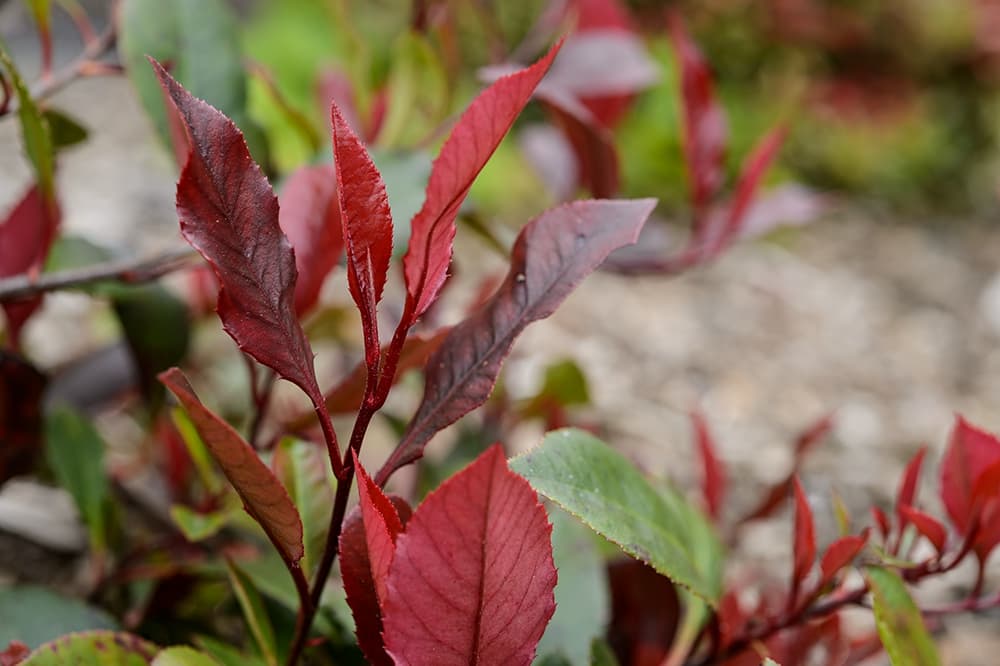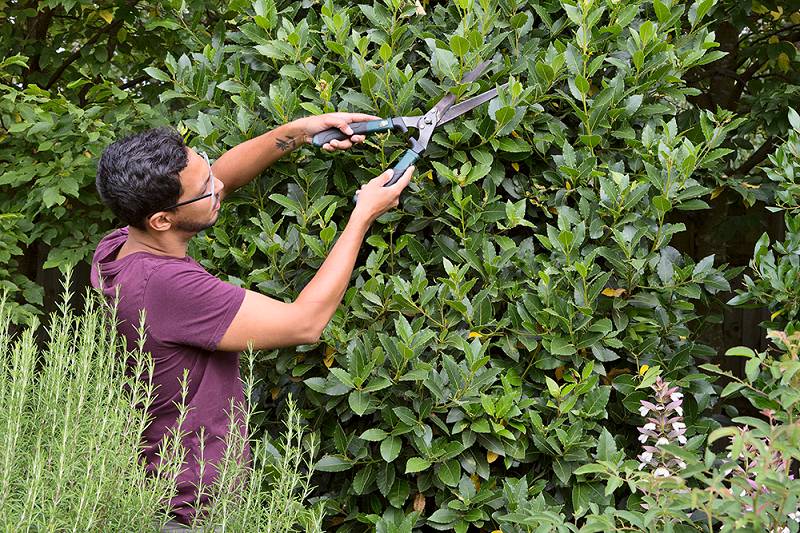The 13 most beautiful evergreen hedges for your garden

Craving more greenery around your house in the dead of winter? Plant an evergreen hedge! It's the easiest way to make your garden green all year round. As a bonus, an evergreen hedge creates more privacy, adds structure to your borders, and attracts more wildlife to your garden.
Read more below the advertisement
Tip! Read more tips for evergreen hedges later in the article!
There is a suitable evergreen hedge for every garden and style – from well-known classics to evergreen hedges with flowers and berries.
These classic evergreen hedges are ideal for gardens with a timeless look.

The cherry laurel ( Prunus laurocerasus ) resembles the true laurel ( Laurus nobilis) , but has narrower, more elegant leaves and is more disease-resistant. It grows vigorously and forms a full, dense hedge. An excellent choice if you're looking for a chic look with minimal fuss. Alternatively, you could choose the Portuguese laurel ( Prunus lusitanica ), which has smaller leaves and grows more upright.
- Height x width: Up to 3-4 m high, approx. 1.5-2 m wide.
- Benefits: Ornamental foliage, strong and healthy, good for privacy.
- Disadvantages: Grows more slowly than common laurel.



The yew is a classic among evergreen hedges. With its dark green needles and tranquil appearance, it lends a robust character to gardens. Because it grows slowly, pruning yew is a job you only need to do once a year. Moreover, yews often live for decades, even centuries—an investment you'll enjoy for generations.
- Height x width: Up to 4-5 m high, approx. 1-2 m wide.
- Advantages: Little pruning required, long lifespan, very easy to keep neat.
- Disadvantages: Slow growing, very poisonous berries.


Boxwood makes a good hedge along paths or in ornamental gardens: it grows slowly and is also easy to prune into any desired shape. However, the boxwood moth and boxwood fungus have caused considerable damage in recent years. To prevent such problems, consider one of the many boxwood alternatives , such as Ilex crenata .
- Height x width: Up to 1.5 m high, approx. 0.5–1 m wide.
- Advantages: Compact, classic, easy to prune into shape.
- Disadvantages: Susceptible to diseases and pests, slow grower.

- When should I prune which plant?
- What should I pay attention to when pruning?
- The best tips for a blooming garden.

If you want (even) more biodiversity in your garden, a berry hedge is a great choice. Many birds and insects benefit from it.

With its glossy, spiky leaves and red berries, holly is a real eye-catcher in the garden. Birds love the berries, making your hedge extra vibrant in winter. Moreover, holly thrives in a variety of soil types and remains beautifully compact even without much attention. Many beautiful holly varieties are available – including thornless and variegated leaves.
- Height x width: Up to 3-4 m high, approx. 1.5-2 m wide.
- Benefits: Decorative, bird-friendly, winter-hardy.
- Disadvantages: Usually spiky leaves.

Burglars and cats beware! The imposing spines of the firethorn ( Pyracantha ) are not to be braved. This hedge plant is ideal for training along a wall or fence. Firethorn combines dark green leaves with spines and brightly colored berries in yellow, orange, or red. This not only looks beautiful but also attracts birds.
- Height x width: Up to 3-4 m high, approx. 2 m wide.
- Advantages: Decorative berries, bird-friendly, easy to train.
- Disadvantages: Huge thorns (be careful with pruning!), can be susceptible to fire blight.


Although ivy ( Hedera ) isn't officially a hedge plant, this evergreen climber can form a perfect green hedge with a trellis or fence. It grows densely and quickly, stays green year-round, and attracts insects. In winter, birds love the berries. Also handy: ivy is shade-tolerant and grows in almost any soil type.
- Height x width: Variable, grows unlimited in height with some support.
- Advantages: Fast coverage, inexpensive, strong and versatile.
- Disadvantages: Can spread and requires regular pruning to keep it under control.
Tip: If you don't necessarily want an evergreen hedge, a deciduous edible hedge might be a good option. This combines more greenery with tasty fruit.
Tip!
You don't have to choose just one of the many shades of green, because scent and color are also possible.

The camellia is not only one of the most beautiful evergreen shrubs , but also a real eye-catcher with its stunning spring flowers in red, pink, or white. It grows slowly and compactly, making it perfect for smaller gardens or as a unique hedge. A good alternative to Camellia japonica is a rhododendron hedge.
- Height x width: Up to 2–3 m tall, approx. 1.5–2 m wide.
- Advantages: Evergreen and profusely flowering, slow and compact.
- Disadvantages: Sensitive to severe frost during flowering, requires acidic soil.

The holly resembles common holly in its foliage, but has an extra surprise in store: in spring, jasmine-like white flowers appear, which smell wonderful and attract many bees. Osmanthus delavayi and Osmanthus x burkwoodii are excellent evergreen holly varieties.
- Height x width: Up to 3 m high, approx. 1.5 m wide.
- Benefits: Fragrant blooms, compact growth, decorative foliage.
- Disadvantages: Grows slowly.

The Photinia fraseri 'Red Robin' has achieved star status. We, too, are captivated by its fiery red new shoots and fragrant white flowers in spring, which contrast beautifully with the dark green foliage. This creates a hedge that changes color throughout the year. Prune Photinia fraseri annually after flowering to achieve the desired shape and size.
- Height x width: Up to 3 m high, approx. 1.5-2 m wide.
- Advantages: Colorful, decorative, fairly fast growing.
- Disadvantages: Susceptible to leaf diseases, requires a sunny spot.
If you want a fast-growing green hedge, these plants are a good choice. They respond well to regular pruning and are often quite tolerant of wind and changing conditions.

With its gray-green leaves and silvery undersides, Elaeagnus ebbingei has a unique appearance. The olive willow grows beautifully densely (sparrows and tits find it a great hiding place) and is resistant to sea winds and drought. In autumn, it produces inconspicuous but delightfully fragrant flowers that buzz with bees.
- Height x width: Up to 3-4 m high, approx. 2 m wide.
- Advantages: Strong, resistant to (sea) wind and drought, fragrant flowers.
- Disadvantages: Grows quickly, so prune olive willow regularly.

Privet ( Ligustrum ) is an all-rounder that grows almost anywhere. It's strong, fast-growing, and loses hardly any leaves in mild winters. This keeps your garden vibrantly green all year round. Privet is also a favorite of birds and insects – ideal if you want to attract lots of wildlife to your garden. Variegated varieties are also available, for example, in beautiful golden-yellow hues.
- Height x width: Up to 3 m high, approx. 1.5 m wide.
- Advantages: Grows quickly, is inexpensive to purchase, attracts many animals.
- Disadvantages: May lose some leaves in severe winters, prune privet regularly.


This species of cardinal's hat is a robust, evergreen plant with strikingly variegated leaves (green-white or green-yellow). Euonymus fortunei remains low and compact, adding a playful touch to the garden. It is often used as a low evergreen hedge or border divider.
- Height x width: Up to 1.5 m high, approx. 1 m wide.
- Advantages: Colorful foliage, low maintenance, strong.
- Disadvantages: Slow growing, less suitable for tall hedges.

Bamboo instantly brings an exotic ambiance to your garden. Be sure to choose a non-invasive bamboo , such as Fargesia , so the plant doesn't spread across the street. Bamboo is ideal for a playful, airy hedge that stays fresh and green year-round.
- Height x width: Up to 2–4 m tall, approx. 1.5–2 m wide.
- Advantages: Fast growing, evergreen, modern appearance.
- Disadvantages: Can grow wide, not suitable for very neat hedges.
An evergreen hedge is more than just a convenient, evergreen boundary. These hedge plants also add structure to your garden – like a natural border. This way, you can easily create more peace and privacy. An evergreen hedge also offers several advantages that a fence doesn't:
- They provide shelter and nesting places for birds.
- Many types of evergreen hedges provide food for birds and beneficial insects.
- Green hedges can attract hedgehogs to your garden .
- They don't blow over so easily and create a better microclimate in adjacent borders.
- A garden that remains (partly) green in winter simply feels a lot more cozy.

Not every hedge plant is suitable for every garden. So think ahead:
- How quickly do you want results? Laurel grows rapidly, while yew takes years to reach the same height.
- How much do you feel like pruning? A fast-growing tree requires more frequent maintenance.
- What does your garden look like? Choose a hedge that suits your soil, amount of sun, and the overall look of your garden.
- What do you like? Flowers or no flowers, sleek and formal, or natural and playful?

Don't feel like constantly using hedge trimmers? Then choose yew. It grows slowly, stays dense, and usually only needs one pruning a year.

Perhaps a better question is: " When is the cheapest evergreen hedge?" It's best to buy hedge plants bare-root during the dormant season (from around November onwards). They're much cheaper then, because they're harvested directly from the field. Plant them immediately afterward, though. That way, they'll have a growth spurt starting in spring.
If you have tons of patience, it's even cheaper to grow your own hedge plants. Taking cuttings from conifers, for example, is very easy. If you do this in September, you can plant them out in the spring.

Want privacy today and a green wall tomorrow? Then laurel is your best friend. It grows 30 to 60 cm per year. But height alone is only half the story. It's good to prune your laurel regularly, especially just after planting. This will make your hedge grow denser. If you just let it grow tall quickly, you won't get as nice and full a hedge as if you use the pruning shears more often.





